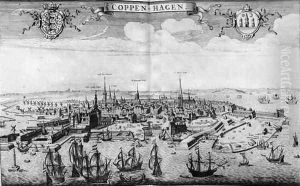Rombout Van den Hoeye Paintings
Rombout Van den Hoeye was a notable figure in the 17th-century Flemish art scene, known for his detailed etchings and engravings which captured the essence of his era. Born in 1622 in Brussels, then part of the Spanish Netherlands, Van den Hoeye was immersed in a rich artistic environment from a young age. The Spanish Netherlands was a center for the arts, especially known for its flourishing Baroque style, which deeply influenced his work.
Van den Hoeye's artistic journey began under the tutelage of prominent artists of his time, though specific mentors are not well-documented. His early works demonstrate a keen understanding of the technical aspects of engraving, as well as a remarkable ability to convey texture, light, and shadow, which became hallmarks of his style. He was particularly adept at creating landscapes and cityscapes, often imbued with a sense of liveliness and attention to detail that invited viewers to explore every inch of the scene.
Throughout his career, Van den Hoeye traveled across Europe, drawing inspiration from different landscapes and artistic styles. These travels were crucial in developing his unique approach to engraving, which combined Flemish attention to detail with Italianate influences in composition and perspective. His works often featured architectural elements and pastoral scenes, executed with a precision that was ahead of his time.
Despite his talent and contribution to the art of engraving, Rombout Van den Hoeye did not achieve the same level of fame as some of his contemporaries. His works, however, were collected and admired by connoisseurs and art lovers, and they continued to be appreciated for their technical excellence and artistic beauty. Van den Hoeye's engravings capture the essence of 17th-century European landscape and city life, making them valuable historical documents as well as artistic treasures.
Rombout Van den Hoeye passed away in 1670, leaving behind a legacy that, while not widely known outside of art historical circles, is deeply appreciated for its contribution to the development of engraving techniques and the art of the Baroque period. His works remain a testament to the skill and creativity of Flemish artists in the 17th century, offering insight into the world as it was seen through their eyes.
